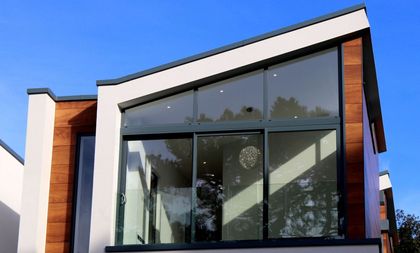How Residential Window Tinting Enhances Your Home's Power Efficiency
Residential window tinting offers an engaging solution for homeowners seeking to enhance energy efficiency within their home. By using specialized films to windows, it properly decreases warmth transfer, thereby stabilizing interior temperature levels and lessening the requirement for extreme home heating or air conditioning. This not only reduces power intake however likewise gives a more comfortable environment by alleviating glare. Understanding the nuances of how tinting jobs and picking the suitable type for your home can be critical. Oddly, what aspects should one consider prior to making this financial investment?
Comprehending Home Window Tinting
Comprehending home window tinting is essential for homeowners looking for to enhance both comfort and power efficiency in their living spaces. Residential Window Tint. Home window tinting entails the application of a thin film to the inside or exterior surface of glass home windows. This movie can significantly regulate the quantity of sunshine and warmth that enters a home, hence affecting indoor environment problems
There are various types of home window tinting films offered, each with unique residential or commercial properties. The effectiveness of window tinting is typically gauged by its Visible Light Transmission (VLT) portion, which shows how much light can pass via the film.
Advantages of Power Performance
Window tinting not only enhances aesthetic appeals but likewise plays a considerable duty in improving energy efficiency within property rooms. By lowering warmth transfer through windows, tinted movies develop a more steady indoor environment, which can bring about substantial decreases in power intake for heating & cooling. This energy efficiency equates into lower utility expenses, supplying house owners with considerable lasting savings.

In addition, home window tinting enhances the convenience of living rooms. By decreasing glare and obstructing unsafe UV rays, colored home windows develop a more pleasurable setting, which can bring about enhanced health for passengers. The protection against UV rays likewise aids maintain furnishings and floor covering from fading, adding to the durability of family products.
Exactly How Tinting Functions
Tinting movies operate via a combination of innovative products and innovations created to control the quantity of solar power entering a home. Mostly composed of polyester, these movies usually include metallic or ceramic fragments that mirror and take in warmth. This dual ability enables them to significantly minimize the penetration of ultraviolet (UV) rays and infrared radiation while permitting visible light to pass through.
The efficiency of window tinting is determined by its solar warmth gain coefficient (SHGC), which suggests just how much solar energy is transmitted via the home window. Lower SHGC values are more suitable as they denote better warm being rejected. Furthermore, window colors can include a range of tones, allowing homeowners to tailor their visual choices while enhancing power efficiency.
In addition, these films serve as a barrier, stopping heat loss during chillier months by showing interior warmth back into the living room. This thermal insulation result enhances the cooling advantages gotten throughout warmer months, adding to a well balanced indoor climate year-round. By handling solar power successfully, household home window tinting not only boosts comfort however likewise plays an important function in minimizing power usage and lowering energy expenses.
Choosing the Right Color

There are different types of window films offered, consisting of dyed, metalized, and ceramic. Dyed movies are economical yet might have limited sturdiness. Metalized movies provide far better warm being rejected but can hinder digital signals. Ceramic movies offer excellent warmth control without jeopardizing presence and are very durable, making them a prominent selection.
Visible light transmission (VLT) is another important element, as it shows the amount of natural light that can travel through the colored glass. Home owners ought to pick a color with a VLT that matches their illumination choices while still giving adequate glow decrease.
Additionally, assessing the solar warmth gain coefficient (SHGC) can assist figure out exactly how well a color can obstruct warmth from sunlight. A lower SHGC indicates better warm control, ultimately enhancing power efficiency.
Setup and Upkeep Tips
Correct setup and maintenance are important components in making the most of the advantages of household window tinting. To achieve optimum results, it is suggested to hire a certified expert for setup. This makes certain that the color is applied appropriately, avoiding air bubbles, wrinkles, or imbalance that can endanger efficiency. Specialists additionally use specialized devices and techniques, which can boost the resilience and efficiency of the color.
Complying with setup, upkeep is vital to extend the life of the home window film. It is recommended to wait at least 30 days prior to cleaning up the tinted home windows to allow the glue to treat completely.
Addressing these issues without delay can avoid further damages and preserve power effectiveness. By adhering to these setup and maintenance suggestions, property owners can guarantee their home window tinting proceeds to provide significant power cost savings and convenience for years to come.
Verdict
In final these details thought, domestic home window tinting offers as a reliable solution for enhancing power effectiveness within homes. By minimizing warm transfer and blocking dangerous UV rays, window films contribute to decrease power consumption and improved indoor convenience.
Window tinting includes the application of a thin film to the interior or outside surface area of glass home windows. By reducing warmth transfer through windows, tinted films his response create a much more stable interior environment, which can lead to significant decreases in power usage for heating and air conditioning.The performance of home window tinting is measured by its solar heat gain coefficient (SHGC), which shows how much solar energy is transmitted with the home window. By handling solar energy efficiently, property home window tinting not only enhances convenience but additionally plays an essential duty in minimizing power intake and reducing energy expenses.
By lowering warmth transfer and obstructing dangerous UV rays, home window films contribute to reduce energy intake and improved indoor comfort.